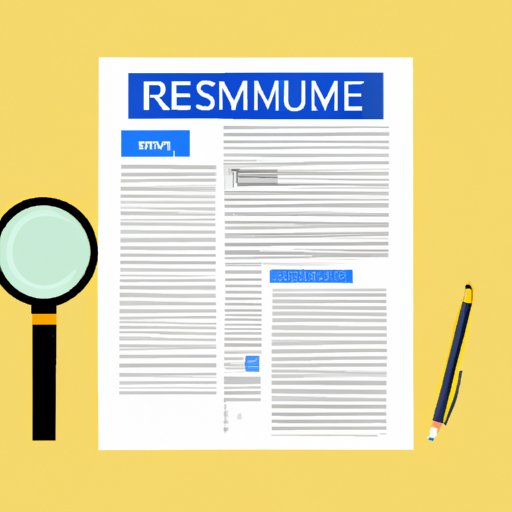Writing a Winning Resume: A Complete Guide
Having a strong, well-written resume is crucial in today’s job market. It’s often the first impression a potential employer will have of you, and it can be the deciding factor in getting an interview. A solid resume highlights your skills and experience and showcases your achievements. However, with so much emphasis placed on resumes, it can be challenging to know where to start. In this article, we provide a complete guide to writing a winning resume, including common mistakes to avoid, tips on personalizing and tailoring your resume, and more.
Step-by-Step Guide
The first step in creating a great resume is to gather personal information. This includes your name, address, contact information, and work history. Once you have all the relevant information, you can start crafting the perfect resume. Here are some steps to follow:
Identify Key Skills and Achievements
The next step is to identify your key skills and achievements. Employers want to know what you can do for them. Make sure each of your skills and achievements is relevant to the job you are applying for. Be specific and use quantifiable data whenever possible. Examples include increasing sales by X%, managing budgets of over Y dollars, or reducing turnaround time by Z%.
Craft Bullet Points that Highlight Accomplishments
Bullet points are an excellent way to highlight your achievements and skills. When writing bullet points, start with an action verb and be as specific as possible about the results you achieved. Use numbers to quantify your accomplishments, such as “Managed a team of eight employees and exceeded monthly sales targets by 20%.”
Organize Skills and Experiences in Order of Relevance
Organizing your skills and experience in order of relevance to the job is crucial. Make sure the most relevant information is listed first. In general, work experience should be listed in reverse chronological order, with the most recent job first.
Choose an Appropriate Layout and Format
There are various resume formats to choose from. Select one that best showcases your skills and experience. A chronological resume is the most common format, while a functional resume emphasizes skills and abilities. A hybrid resume is a combination of both. Make sure to choose a clean and simple layout that is easy to read.
Addressing Common Mistakes
Even the best resumes are not perfect, and there are common mistakes made that could cost you a job. Here are some things to avoid:
Grammar Errors
Spelling and grammar mistakes can be a deal-breaker for employers. Use spell check and proofread your resume carefully. Ask a friend or colleague to review your resume as well.
Lack of Quantifiable Data
Employers want to see results. If you’re unable to quantify your achievements, it makes it harder for employers to understand your value. Be specific about your accomplishments and use numbers whenever possible.
Irrelevant Information
Do not include irrelevant information in your resume. Details such as hobbies, your marital status, or your age may not be necessary, and they may even work against you. Focus on relevant skills, experience, and achievements that are aligned with the job you are applying for.
Tailoring for Specific Jobs
Tailoring your resume for specific jobs is crucial. The job market is competitive, and you need to show that you’re the best fit for the role. Here are some tips to help you tailor your resume for specific jobs:
Research the Industry and Use Relevant Keywords
Research the industry and use relevant keywords in your resume. Read job descriptions carefully and make sure your skills and experience match those listed in the job posting.
Emphasize Skills and Experiences Most Relevant to the Job
Emphasize your most relevant experiences and skills for the job. Try to align your resume with the job description as much as possible. Use bullet points to emphasize your achievements and skills that match the job’s requirements.
Showing Personality
While a resume should be professional, it’s also essential to show some personality. Personalizing your resume helps you stand out from the crowd. Here are some ways to show your individuality:
Use a Personal Statement
A personal statement is an excellent way to showcase your personality and values. It’s a short, concise summary of yourself that can be included at the top of your resume. Avoid clichés and be authentic.
Add Personal Touches
Adding personal touches such as your hobbies, interests, or volunteering experience can help you stand out. However, make sure the information is relevant to the job you’re applying for.
Mistakes to Avoid
Here are some mistakes that could hurt your chances of getting an interview:
Overly Generic Language
Avoid using generic language in your resume. Be specific about your achievements and use industry-specific terms and phrases when appropriate.
Typos
Spelling and grammar mistakes can be a deal-breaker for employers. Double-check your resume, get a friend to proofread it, and use tools like Grammarly to ensure there are no mistakes.
Inconsistencies
Make sure there are no discrepancies in your resume. Check for consistency in formatting, dates, and job titles.
Conclusion
Crafting a winning resume takes time, effort, and attention to detail. By following this step-by-step guide and avoiding common mistakes, you should be well on your way to creating a compelling resume that showcases your skills and experience.
